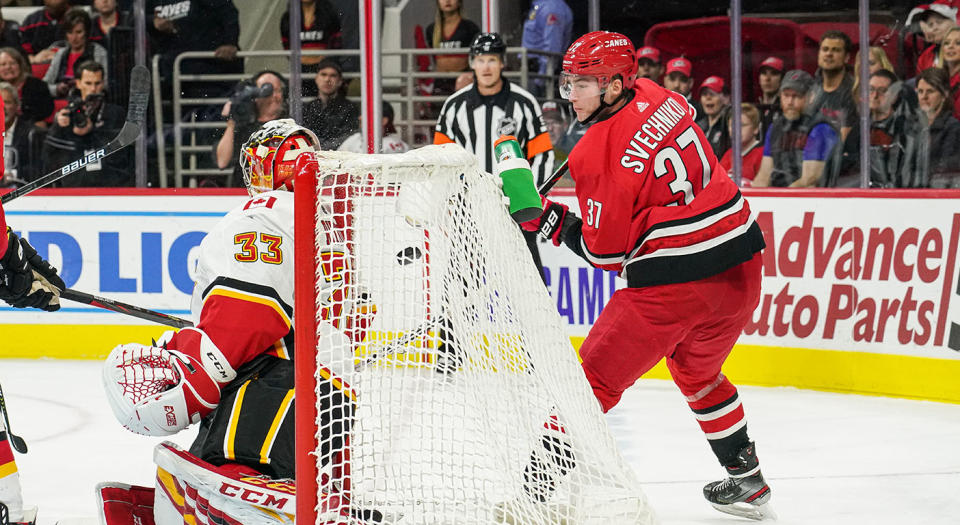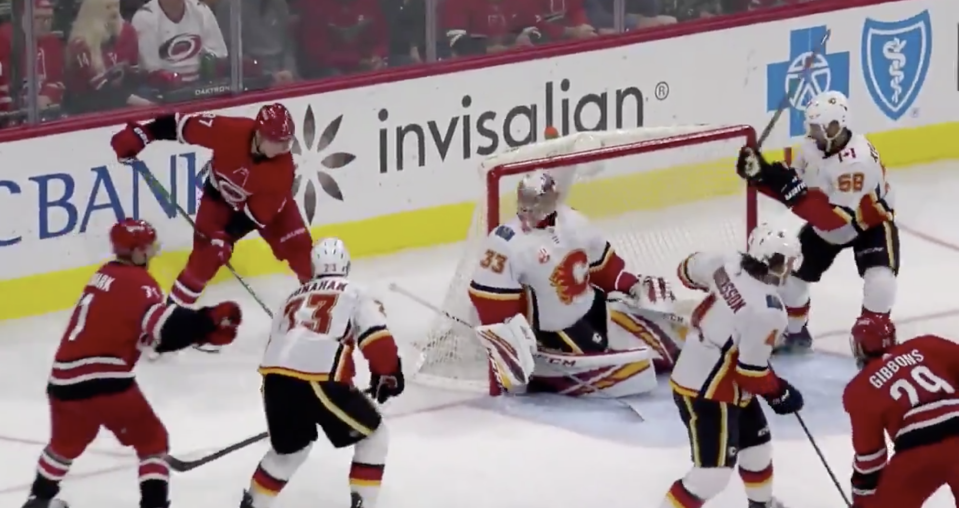Why the 'lacrosse' goal is much more than a hotdog move

It happened, and it’s glorious. More than 23 years after Mike Legg seemingly defied physics and converted the infamous “Michigan goal” during a 1996 NCAA Tournament game against Minnesota, a young, mega-skilled up-and-coming star tried the lacrosse style move in a regular-season NHL game — and it worked.
It’s crafty Carolina Hurricanes forward Andrei Svechnikov we have to thank for this beautiful chaos, for having the intestinal fortitude, and sheer talent, to bring this gem of a move out of the obscurity of post-practice tomfoolery and outdoor-rink shenanigans and into the mainstream where it belongs.
OH MY GOODNESS Svechnikov pic.twitter.com/30zJGNnjD9
— Yahoo Sports NHL (@YahooSportsNHL) October 30, 2019
Oct. 29 was a powerful day for pro-creativity-in-hockey advocates, with Svechnikov doing his just hours after Vancouver Canucks prospect Nils Höglander put his own twist on the move during a Swedish Hockey League contest.
Nils Höglander is at it again with the lacrosse-style goal! #Canucks
pic.twitter.com/2gGuZwQs5j— /Cam Robinson/ (@Hockey_Robinson) October 29, 2019
Attitudes towards this particular type of wizardry are rapidly evolving for the better, evident by one of the top snipers in the world, Maple Leafs centre Auston Matthews, unsuccessfully trying the move in a game situation earlier this month against the Sharks.
Matthews with a lacrosse goal attempt pic.twitter.com/TJ4DtLa3D6
— Flintor (@TheFlintor) October 26, 2019
Let’s not forget about Kings prospect and fellow puck magician Arthur Kaliyev, who busted out the very same move just a couple weeks ago in the OHL.
🚨 LACROSSE, ANYONE?! 😱😱😱@Arthur_Kaliyev does it again! 5-4 #GoHAM pic.twitter.com/LMpI2JMVc6
— Hamilton Bulldogs (@BulldogsOHL) October 14, 2019
All three of these variations of the move vary slightly, but all have the same central premise: a left-handed shooter sets up for a wraparound and forces the goalie to drop to seal the right post. Execute the scoop and tuck the biscuit into the exposed top corner.
Of course, the move is very aesthetically pleasing and has a certain air of badassery tied to it, but most importantly, when performed correctly in a game situation at top speed, it’s damn well near impossible to stop. It’s no coincidence that three mega-skilled players in Svech, Hoglander and Kaliyev have successfully reeled off different incarnations of the move in three of the best leagues in the world during high-pressure, close-game situations.
It’s no throwaway move, it’s as legit as any.
It’s not a gimmick, nor is it solely a “hotdog” move. It’s a super effective weapon to have in the repertoire, and it’s becoming more prevalent during actual game play because of the sheer skill and creativity some of these players have and the ability to actually pull it off at game speed, along with the confidence to actually try it during in-game situations without the fear of failure if it doesn’t work, or the perception that they’re somehow “disrespecting the game” or “embarrassing their opponent” if they do pull it off successfully.
That boring-ass, old-school mentality is disappearing as the incoming generation takes hold of the sport, and with that comes the realization of just how effective this move can be when timed and executed properly.
Here’s why:
* Goaltenders, for years, have been taught to get their pads flush to the ice and post in some variation or another, generally leaving a good chunk of open space available in the upper part of the net.
* David Rittich is completely shutting down the bottom of the goal in a modified reverse-VH, but there is a plethora of daylight up top. A very good opportunity to bury the biscuit in either of the top corners here, if ONLY a skilled player could figure out a way to scoop the puck and put it there, hmmmm.

* Even once the shooter has committed to the scoop and the goalie does in fact read it and realize the puck is heading for the upper part of the net rather than the lower, his options as far as actually stopping it are extremely limited, especially on the blocker side.
* The goaltender’s stick becomes an impediment and drastically hinders the goalie’s ability to get their blocker to the top part of the net in time, leaving the ‘tender pretty helpless and just hoping to get a chunk of shoulder or mask on it. Just look how tangled up Rittich gets here:

* Lastly, it gives the opposing team another wrinkle to try and game plan for, complicating immensely the way blue-liners and centremen try to defend wraparounds and set plays from behind the net or in tight.
* Oliver Kylington was the unfortunate soul victimized by Svechnikov here, and he’s extremely confused at how to attack the Hurricanes forward once he realizes the puck is going airborne. More chaos will ensue in defensive zones with the threat of scoop-and-tuck wraparounds becoming more prevalent, and if there’s one thing powerful offences and elite puck-handlers love, it’s chaos.

In a sport seemingly perpetually starved for offence, excitement and creativity, this lacrosse-style sorcery is finally having its moment in high-pressure, in-game situations at many of the highest levels of hockey. Prospects to big-name NHL stars are trying it — both successful and not — much more frequently and there’s no reason to suspect this trend will seize to pick up momentum going forward.
Culture is changing, players are more skilled, more creative, and continually looking for new and innovative ways to score. The premise of this move isn’t new or innovative, but the execution ability and willingness to try it definitely is.
More NHL coverage from Yahoo Sports

 Yahoo Sports
Yahoo Sports 


